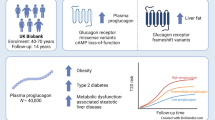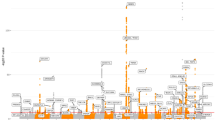Abstract
The concentration of circulating homocysteine has been associated with a variety of diseases, including myocardial infarction, stroke, venous thrombosis and cognitive decline. Genetic variation has been demonstrated to play an important role in determining plasma homocysteine, however, the genes involved are incompletely understood. Ligation of the transcription factor peroxisome proliferator-activated gamma (PPARG) has been demonstrated to lower plasma homocysteine. We examined the association of two sequence variations in PPARG with plasma concentrations of homocysteine in a population-based study of 3,875 elderly men. PPARG c.34G > C and PPARG c.1347C > T sequence variations were determined by real-time quantitative PCR and related to logarithm transformed homocysteine concentrations using linear regression, adjusting for the co-variants age, renal function, smoking, coronary heart disease, waist to hip ratio, diabetes, hypertension and MTHFR g.677C > T sequence variation. Median plasma homocysteine concentration was 10% higher in men who were homozygous for the rare allelic variation in PPARG c.34G > C and PPARG c.1347C > T by comparison to those who had wild type sequence variation. PPARG c.1347C > T (β = 0.038, P = 0.01 recessive model; β = 0.036, P = 0.02 dominant model) sequence variation was positively associated with homocysteine concentration after adjusting for co-variants. The two PPARG sequence variations were in linkage disequilibrium and the common haplotype was associated with lower plasma homocysteine (P = 0.005). Our findings demonstrate a new genotypic association with plasma homocysteine. Replication will be required in other cohorts.
Similar content being viewed by others
References
B-Vitamin Treatment Trialists’ Collaboration (2006) Homocysteine-lowering trials for prevention of cardiovascular events: a review of the design and power of the large randomized trials. Am Heart J 151:282–287
Bathum L, Petersen I, Christiansen L, Konieczna A, Sorensen TI, Kyvik KO (2007) Genetic and environmental influences on plasma homocysteine: results from a Danish twin study. Clin Chem 53:971–979
Brattstrom L, Lindgren A, Israelsson B, Andersson A, Hultberg B (1994) Homocysteine and cysteine: determinants of plasma levels in middle-aged and elderly subjects. J Intern Med 236:633–641
Castro R, Rivera I, Blom HJ, Jakobs C, Tavares de Almeida I (2006) Homocysteine metabolism, hyperhomocysteinaemia and vascular disease: an overview. J Inherit Metab Dis 29:3–20
Cesari M, Zanchetta M, Burlina A, Pedon L, Maiolino G, Sticchi D, Pessina AC, Rossi GP (2005) Hyperhomocysteinemia is inversely related with left ventricular ejection fraction and predicts cardiovascular mortality in high-risk coronary artery disease hypertensives. Arterioscler Thromb Vasc Biol 25:115–121
Deeb SS, Fajas L, Nemoto M, Pihlajamaki J, Mykkanen L, Kuusisto J, Laakso M, Fujimoto W, Auwerx J (1998) A Pro12Ala substitution in PPARgamma2 associated with decreased receptor activity, lower body mass index and improved insulin sensitivity. Nat Genet 20:284–287
den Heijer M, Lewington S, Clarke R (2005) Homocysteine, MTHFR and risk of venous thrombosis: a meta-analysis of published epidemiological studies. J Thromb Haemost 3:292–299
den Heijer M, Willems HP, Blom HJ, Gerrits WB, Cattaneo M, Eichinger S, Rosendaal FR, Bos GM (2007) Homocysteine lowering by B vitamins and the secondary prevention of deep vein thrombosis and pulmonary embolism: a randomized, placebo-controlled, double-blind trial. Blood 109:139–144
Fredriksen A, Meyer K, Ueland PM, Vollset SE, Grotmol T, Schneede J (2007) Large-scale population-based metabolic phenotyping of thirteen genetic polymorphisms related to one-carbon metabolism. Hum Mutat (in press)
Frosst P, Blom HJ, Milos R, Goyette P, Sheppard CA, Matthews RG, Boers GJ, den Heijer M, Kluijtmans LA, van den Heuvel LP (1995) A candidate genetic risk factor for vascular disease: a common mutation in methylenetetrahydrofolate reductase. Nat Genet 10:111–113
Golledge J, Muller J, Shephard N, Clancy P, Smallwood L, Moran C, Dear AE, Palmer LJ, Norman PE (2007) Association between osteopontin and human abdominal aortic aneurysm. Arterioscler Thromb Vasc Biol 27:655–660
Haan MN, Miller JW, Aiello AE, Whitmer RA, Jagust WJ, Mungas DM, Allen LH, Green R (2007) Homocysteine, B vitamins, and the incidence of dementia and cognitive impairment: results from the Sacramento area Latino study on aging. Am J Clin Nutr 85:511–517
Homocysteine Studies Collaboration (2002) Homocysteine and risk of ischemic heart disease and stroke: a meta-analysis. JAMA 288:2015–2022
Jamrozik K, Norman PE, Spencer CA, Parsons RW, Tuohy R, Lawrence-Brown MM, Dickinson JA (2000) Screening for abdominal aortic aneurysm: lessons from a population-based study. Med J Aust 173:345–350
Janosikova B, Zavadakova P, Kozich V (2005) Single-nucleotide polymorphisms in genes relating to homocysteine metabolism: how applicable are public SNP databases to a typical European population? Eur J Hum Genet 13:86–95
Jaziri R, Lobbens S, Aubert R, Pean F, Lahmidi S, Vaxillaire M, Porchay I, Bellili N, Tichet J, Balkau B, Froguel P, Marre M, Fumeron F; DESIR Study Group (2006) The PPARG Pro12Ala polymorphism is associated with a decreased risk of developing hyperglycemia over 6 years and combines with the effect of the APM1 G-11391A single nucleotide polymorphism: the data from an epidemiological study on the insulin resistance syndrome (DESIR) study. Diabetes 55:1157–1162
Jee SH, Song KS, Shim WH, Kim HK, Suh I, Park JY, Won SY, Beaty TH (2002) Major gene evidence after MTHFR-segregation analysis of serum homocysteine in families of patients undergoing coronary arteriography. Hum Genet 111:128–135
Kullo IJ, Ding K, Boerwinkle E, Turner ST, Mosley TH Jr, Kardia SL, de Andrade M (2006) Novel genomic loci influencing plasma homocysteine levels. Stroke 37:1703–1709
Lohmueller KE, Pearce CL, Pike M, Lander ES, Hirschhorn JN (2003) Meta-analysis of genetic association studies supports a contribution of common variants to susceptibility to common disease. Nat Genet 33:177–182
Loscalzo J (2006) Homocysteine trials–clear outcomes for complex reasons. N Engl J Med 354:1629–1632
McLean RR, Jacques PF, Selhub J, Tucker KL, Samelson EJ, Broe KE, Hannan MT, Cupples LA, Kiel DP (2004) Homocysteine as a predictive factor for hip fracture in older persons. N Engl J Med 350:2042–2049
Murthy SN, Obregon DF, Chattergoon NN, Fonseca NA, Mondal D, Dunne JB, Diez JG, Jeter JR Jr, Kadowitz PJ, Agrawal KC, McNamara DB, Fonseca VA (2005) Rosiglitazone reduces serum homocysteine levels, smooth muscle proliferation, and intimal hyperplasia in Sprague–Dawley rats fed a high methionine diet. Metabolism 54:645–652
Norman PE, Jamrozik K, Lawrence-Brown MM, Le M, Spencer CA, Tuohy R, Parsons R, Dickinson JA (2004) Impact of screening on mortality from abdominal aortic aneurysm: results of a large, population-based randomised controlled trial. BMJ 329:1259–1262
Norton K, Whittingham N, Carter L, Kerr D, Gore C, Marfell-Jones M (2000) Measurement techniques in anthropometry. In: Norton K, Olds T (eds) Anthropometrica. UNSW, Sydney, pp 27–75
Orio F Jr, Matarese G, Di Biase S, Palomba S, Labella D, Sanna V, Savastano S, Zullo F, Colao A, Lombardi G (2003) Exon 6 and 2 peroxisome proliferator-activated receptor-gamma polymorphisms in polycystic ovary syndrome. J Clin Endocrinol Metab 88:5887–5892
Reed T, Malinow MR, Christian JC, Upson B (1991) Estimates of heritability of plasma homocyst(e)ine levels in aging adult male twins. Clin Genet 39:425–428
Sacco RL, Anand K, Lee HS, Boden-Albala B, Stabler S, Allen R, Paik MC (2004) Homocysteine and the risk of ischemic stroke in a triethnic cohort: the NOrthern MAnhattan study. Stroke 35:2263–2269
Sahin M, Tutuncu NB, Ertugrul D, Tanaci N, Guvener ND (2007) Effects of metformin or rosiglitazone on serum concentrations of homocysteine, folate, and vitamin B12 in patients with type 2 diabetes mellitus. J Diabetes Complications 21:118–123
Sharma AM, Staels B (2007) Peroxisome proliferator-activated receptor gamma and adipose tissue—understanding obesity-related changes in regulation of lipid and glucose metabolism. J Clin Endocrinol Metab 92:386–395
Souto JC, Blanco-Vaca F, Soria JM, Buil A, Almasy L, Ordonez-Llanos J, Martin-Campos JM, Lathrop M, Stone W, Blangero J, Fontcuberta J (2005) A genomewide exploration suggests a new candidate gene at chromosome 11q23 as the major determinant of plasma homocysteine levels: results from the GAIT project. Am J Hum Genet 76:925–933
Troughton JA, Woodside JV, Young IS, Arveiler D, Amouyel P, Ferrieres J, Ducimetiere P, Patterson CC, Kee F, Yarnell JW, Evans A; PRIME Study Group (2007) Homocysteine and coronary heart disease risk in the PRIME study. Atherosclerosis 191:90–97
Wang XL, Oosterhof J, Duarte N (1999) Peroxisome proliferator-activated receptor gamma C161→T polymorphism and coronary artery disease. Cardiovasc Res 44:588–594
Yen CJ, Beamer BA, Negri C, Silver K, Brown KA, Yarnall DP, Burns DK, Roth J, Shuldiner AR (1997) Molecular scanning of the human peroxisome proliferator activated receptor gamma (hPPAR gamma) gene in diabetic Caucasians: identification of a Pro12Ala PPAR gamma 2 missense mutation. Biochem Biophys Res Commun 241:270–274
Acknowledgments
The authors extend their thanks to the participants and staff involved in the Western Australian AAA Screening Study and Health In Men Study. Funding from the National Institute of Health, USA (RO1 HL080010-01) and NHMRC (project grant 379600) supported this work. JG and PEN hold Practitioner Fellowships from the NHMRC, Australia (431503 and 45805).
Author information
Authors and Affiliations
Corresponding author
Rights and permissions
About this article
Cite this article
Golledge, J., Norman, P.E. Relationship between two sequence variations in the gene for peroxisome proliferator-activated receptor-gamma and plasma homocysteine concentration. Health in men study. Hum Genet 123, 35–40 (2008). https://doi.org/10.1007/s00439-007-0446-8
Received:
Accepted:
Published:
Issue Date:
DOI: https://doi.org/10.1007/s00439-007-0446-8




